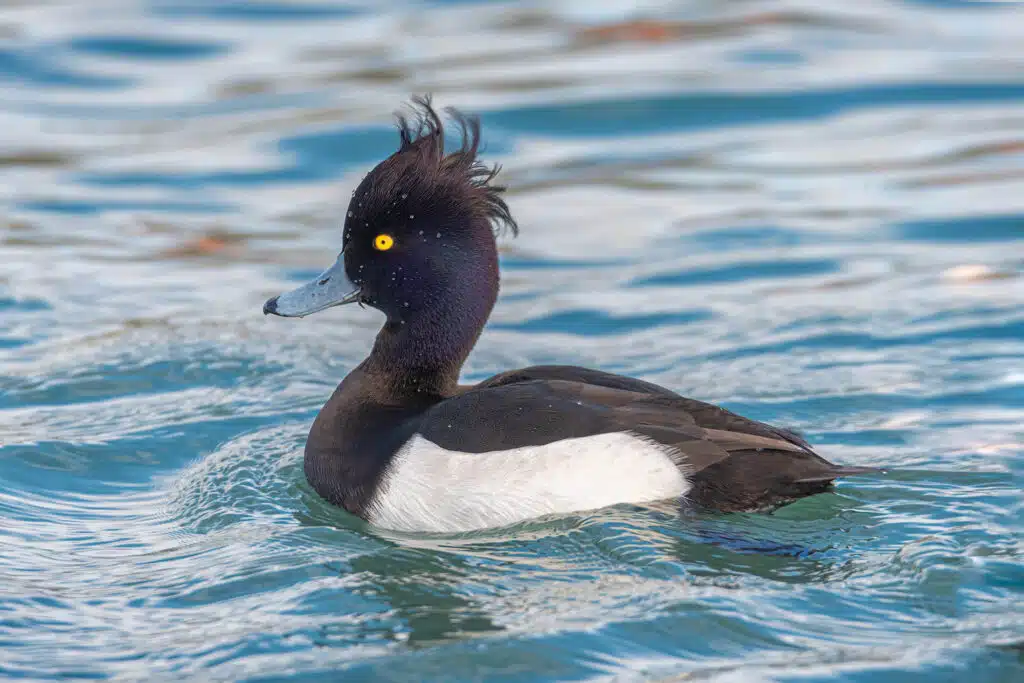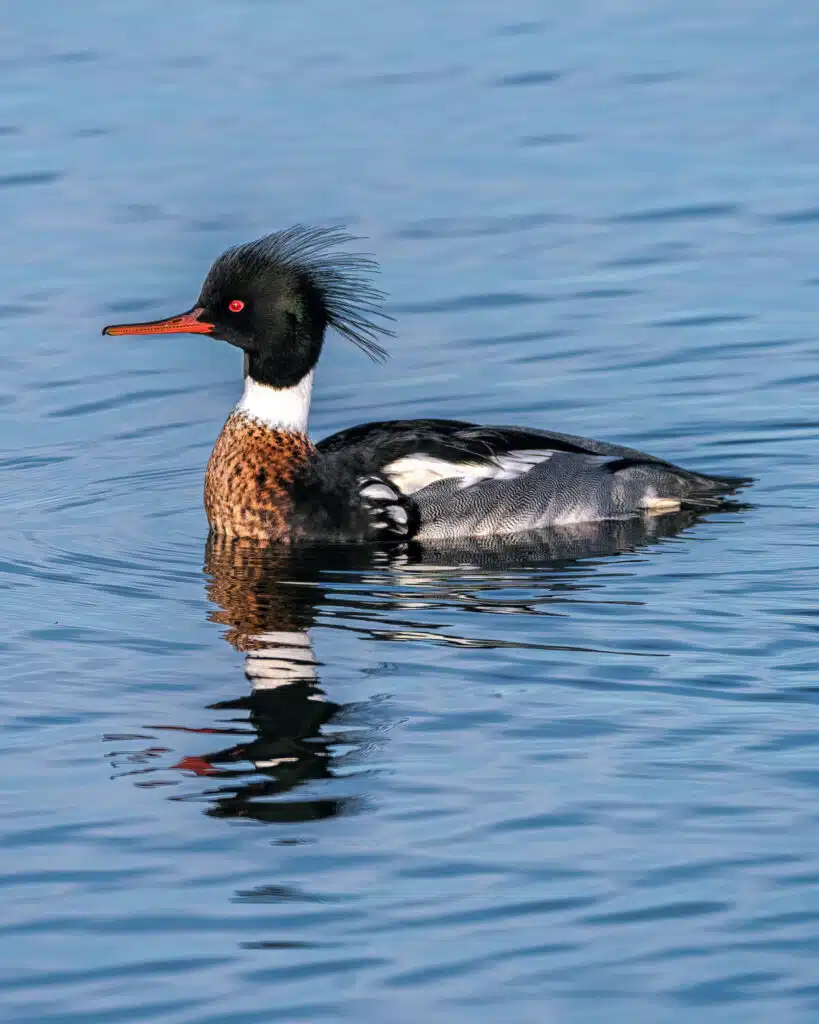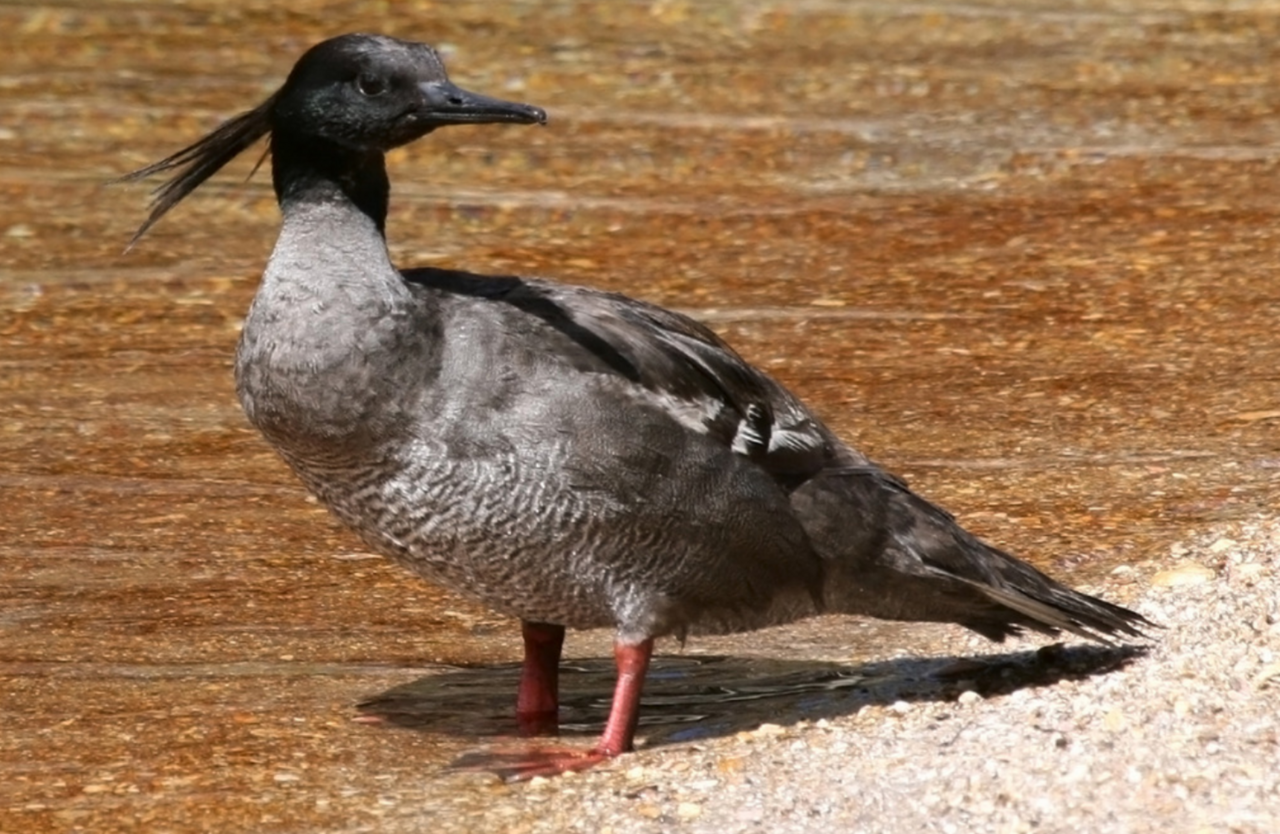Some ducks appear as if having afro (or mohawk) hair. This is, in fact, a type of crest. Feathers can grow longer on the head of various types of ducks.
In some cases, these feathers are short. In others, they are long and can even be raised or lowered.
Several wild ducks with afros are known to have afro-like crests only in the case of males.
Domestic ducks may also show crests. Unlike in wild ducks, these can be the result of genetic defects, even killing ducks before they hatch.
Mohawk ducks can be numerous or almost extinct, depending on their habitat, risks, and food availability.
Migrating ducks are some of the most numerous, as they can easily move for food or shelter.
They can also move whenever pollution or human activity impacts their environment.
Some of the most at-risk ducks with mohawks are those that don’t migrate and that need very specific conditions, such as clean rivers to live in as The Brazilian Merganser.
Crests or afros are seen on the following types of wild or domestic ducks which can have large or small populations around the world.
Table of Contents
1. Hooded Merganser

Hooded Mergansers (Lophodytes cucullatus) are among the most common types of ducks with afro hair.
An estimated number of up to 390.000 ducks makes this widespread North American species highly common.
If many types of ducks have mohawk crests for males or females alone, both male and female Hooded Mergansers have this type of crest.
A fluffy mohawk is seen on the crest of males and females. This is a movable section that goes up or down.
The crest itself is visible both during or outside the breeding season.
It’s during the breeding season that the crest can stand out more on males as they change plumage.
White and black sections on the head of the male make its crest stand out. Male ducks have white sides of the head while the crest itself and the head are black.
Females are brown-dominated. Their heads have an almost uniform brown nuance which is also seen across the mohawk.
Common in North America, this is a afro duck with slight population increases from the West Coast to the East Coast.
It can also be found in Europe, on occasion, mainly as strays.
2. Tufted Duck

If Hooded Mergansers are among the most numerous afro hair ducks in North America, Tufted Ducks (Aythya fuligula) are among the most numerous in the world.
By some estimates, there are almost 3 million Tufted Ducks in Europe, Asia, and North America.
As one of the most common species of ducks with crests or afros, this is a species that can be seen along coasts and on lakes.
Both males and females share a mohawk. The black head of the male might make it seem as if their crests are fuller or longer.
In reality, these types of ducks only have a long crest at the back of their heads. This crest can be lowered or raised, according to the state of the duck.
Males have a black mohawk while females have a brown mohawk, in congruence with the color of their heads.
On occasion, the black mohawk of males can also show green iridescence as this is a trait of male head colors going into the breeding season.
Lakes, ponds, and other slow-moving waters are the quieter areas the duck prefers for breeding.
These are also the times when the black-green mohawk of the males can be spotted.
3. Red-breasted Merganser

Up to 370.000 Red-breasted Mergansers (Mergus serrator) are thought to live in North America, Europe, and Asia.
This is a common species among ducks in general and among those with afros in particular.
Both male and female Red-breasted Mergansers show a mohawk. Smaller than the mohawks of other ducks, these tufts are seen on the top of the head or the crest.
As the head, the mohawk hairs come in different colors. Males have black mohawks while females show brown mohawks.
Males further stand out with their red eyes, signaling them going into the breeding season.
The black mohawk of males is matched by black upper back and wing sections.
The gray-brown mohawks of females are matched by similar nuances across the wings and upper back.
While the mohawk can be used as a means of communication, it may also be used to allow the ducks to swim faster.
They are lowered as the duck dives as Red-breasted Mergansers diver for food such as fish, worms, and water bugs.
The ducks and their afros may be spotted the easiest during their breeding period. As a busy time, this is when the ducks are seen on still waters such as lakes of the world.
4. Smew

A species found in Eurasia and in parts of Alaska, Smew ducks (Mergellus albellus) are a species known for their afros, both for males and females.
Shorter than other duck afros, this is still a physical trait seen in adult Smew ducks.
Males show white afros which match the color of their heads. Females show bright brown or dark brown mohawks that also match the color of their heads.
Red-brown female afros are also seen in some regions.
Males, in general, appear brighter as they are dominated by white nuance. As the mohawk itself, the neck, and base wings of males are also white, and gray for the rest of the body.
Females only have a brown crest and mohawk while their heads and white and their bodies mostly gray.
Gray nuances on females are also darker than the silver-gray nuances on male ducks.
A species that retreats to lakes and ponds in the winter, smew ducks are among the species with afros that show small population reductions over the past decades.
5. Scaly-sided Merganser

An Eastern and Northeastern Asian mohawk duck, Scaly-sided Mergansers (Mergus squamatus) live in small numbers.
Even the most optimistic estimates show there are only up to 4.500 ducks of this species left.
What they are known for, on the other hand, is their afros. These crests are found both in males and females.
Some differences exist between the afros of males and those of females.
The male’s mohawk is black and long. When not raised, it almost touches the back of the male duck.
Females, however, have much shorter mohawks. Brown nuances dominate the mohawk of females at the same time.
Males have a black head and a black crest while females have a brown head and a brown crest.
Black, white, and cream nuances are specific to the rest of the male’s body while the appearance of females is mostly gray and white.
These types of ducks live along forests and wetlands of East Russia and nearby territories.
A species often used to overwinter on rivers, Scaly-sided Mergansers are now mostly found in Russia’s wetlands and forests.
Its preferred rivers and overwintering grounds in China are now lost due to industrialization and agricultural land influences.
6. Common Merganser

Common Mergansers (Mergus merganser) are among the high-number ducks in the world with afros that aren’t easily visible.
By some estimates, there are between 1 and 2.5 million Common Mergansers in the world.
This is a species found in North America, Europe, and Asia.
Regardless of its region, the mohawk of The Common Merganser is lowered most time. The feathers that make it the crest aren’t raised so it appears the duck doesn’t have a mohawk.
Some of the instances, when the feathers of the mohawk are seen, are when the duck returns to the surface after diving for food.
Long black feathers make up the mohawk of males while females show long brown feathers and a matching brown head.
Blackheads and afros of males also turn iridescent green, going into the breeding season.
Still, these crests aren’t raised as the crests of other males in the breeding season.
Black and white feathers cover the body and wings of males while females of the species are mostly gray and white.
Juveniles may also have afros, but they are brown, similar to those of females.
Ducks of the species are seen throughout the year on lakes, ponds, and along coasts. They only move away if the water freezes.
7. Brazilian Merganser

One of the longest and most prominent duck afros is seen on Brazilian Mergansers (Mergus octosetaceus).
Unfortunately, this is one of the rarest types of ducks with afros in the world. By some estimates, there are only around 250 Brazilian Mergansers in the world.
These types of ducks don’t live along the coast or on small islands off the mainland.
They live on rivers, particularly on high altitude fast and clean rivers of Brazil.
The Mohawks of these ducks are long and sometimes colorful.
Males have black mohawks and heads. These mohawks take on a green sheen in the breeding season, as the rest of the head and the upper neck.
The mohawks of these ducks are so long they even touch their shoulders.
Males additionally show gray and dark gray coloring, with some white feathers around the wings.
Unlike in other duck species, females have similar coloring, except for the green sheen.
These types of ducks are highly territorial and don’t migrate.
Even more, these ducks prefer not to migrate even in the case of habitat loss, which makes them even more vulnerable and almost extinct.
8. Bali Duck

Bali Ducks are types of domesticated ducks with crests only found in Bali.
The various health issues of these ducks have made them less popular than other types of meat and egg ducks around the world.
White afros or crests are specific to some of these ducks as not all Bali Ducks are crested.
Their crests are the result of a genetic defect that kills many of them.
By estimates, only 1 in 3 adult Bali Ducks are crested. These types of ducks show a gene defect that makes them crested.
The crest or fat lump presses into their brains, killing most young before even hatching.
Still, these ducks are bred locally for their meats.
Locals have even established different breeding patterns to ensure higher production or survival rate.
This is why most breeding patterns combinate parents with crests with parents without crests. This improves general survival rates.
9. Crested Duck

Crested Ducks are types of domestic ducks bred for show.
These types of ducks have a large mohawk-like crest of a globular shape. This is the result of a genetic deformity.
Most crests are white, as the ducks themselves. However, other colors are also seen in some regions of the world.
Gray, brown, yellow, and even black are all colors the duck can come in.
However, the duck is mostly known for its white plumage, orange beak and legs, white crest, and its upright posture.
This is why its crest can also be gray, black, or brown and white, on occasion.
Even the eggs of Crested Ducks can be colorful. Most of them are white, some are blue.
These ducks are ideal for farms and families as they show friendly and even shy behavior.
A healthy Crested Duck has a lifespan of up to 12 years.
10. Crested Miniature Duck

Crested Miniature Ducks are a recent variant of The Crested Duck. This is a species that has a smaller stature.
Some Crested Miniature Ducks never hatch but most end up being small, mostly white, ducks with a mohawk-like crest.
The crest of these ducks can be so large that some breeders even trim them down. The long feathers of the crest may need to be cut when the duck is sick or too dirty.
This isn’t allowed for the show, however.
Crested Miniature Ducks have white feathers and a white crest.
They also come in many other colors such as gray, brown, black, or tan.
There’s even a black and white Crested Miniature Duck with a black head contrasted by a white crest.
Tan Crested Miniature Ducks are often seen with a white mohawk as well. This means the crest itself doesn’t always have to be the same color as the head.
These small ducks can also come with an iridescent green head.